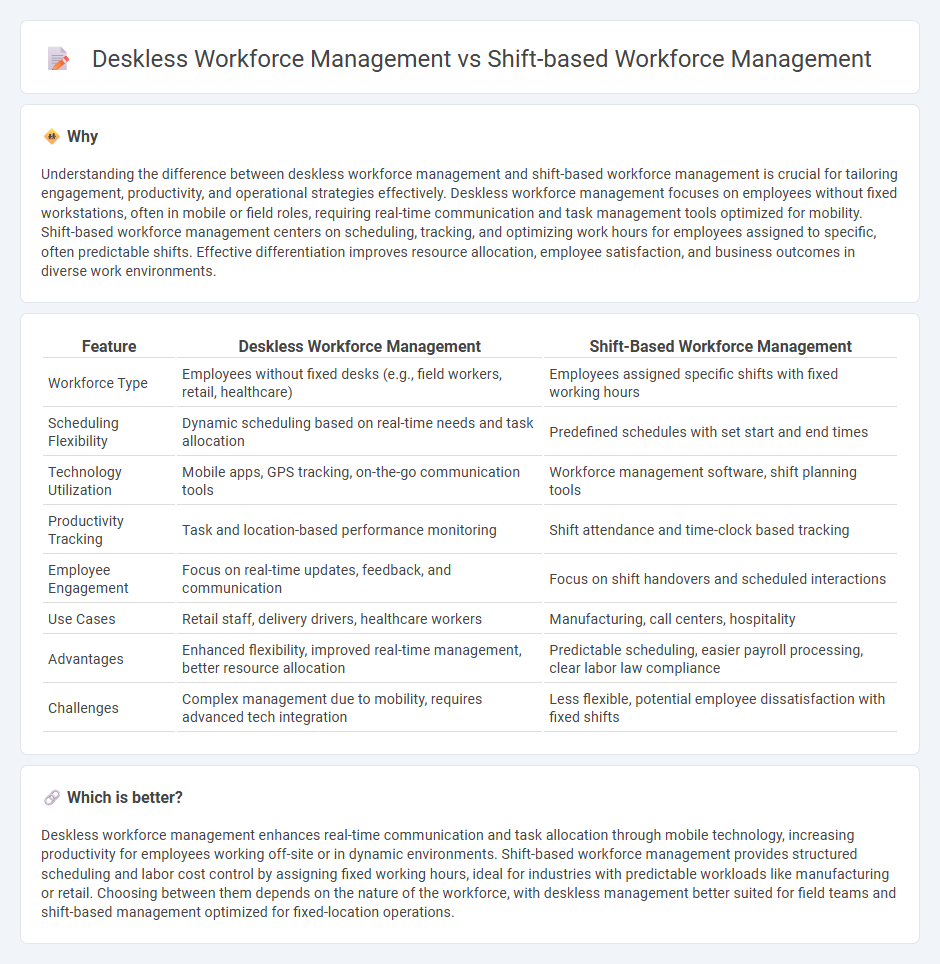
Deskless workforce management focuses on employees who perform their tasks outside traditional office settings, emphasizing mobile communication, real-time task tracking, and flexibility. Shift-based workforce management centers on organizing work schedules with fixed time blocks, ensuring adequate coverage and compliance with labor regulations. Explore effective strategies and tools tailored to optimize both workforce types.
Why it is important
Understanding the difference between deskless workforce management and shift-based workforce management is crucial for tailoring engagement, productivity, and operational strategies effectively. Deskless workforce management focuses on employees without fixed workstations, often in mobile or field roles, requiring real-time communication and task management tools optimized for mobility. Shift-based workforce management centers on scheduling, tracking, and optimizing work hours for employees assigned to specific, often predictable shifts. Effective differentiation improves resource allocation, employee satisfaction, and business outcomes in diverse work environments.
Comparison Table
| Feature | Deskless Workforce Management | Shift-Based Workforce Management |
|---|---|---|
| Workforce Type | Employees without fixed desks (e.g., field workers, retail, healthcare) | Employees assigned specific shifts with fixed working hours |
| Scheduling Flexibility | Dynamic scheduling based on real-time needs and task allocation | Predefined schedules with set start and end times |
| Technology Utilization | Mobile apps, GPS tracking, on-the-go communication tools | Workforce management software, shift planning tools |
| Productivity Tracking | Task and location-based performance monitoring | Shift attendance and time-clock based tracking |
| Employee Engagement | Focus on real-time updates, feedback, and communication | Focus on shift handovers and scheduled interactions |
| Use Cases | Retail staff, delivery drivers, healthcare workers | Manufacturing, call centers, hospitality |
| Advantages | Enhanced flexibility, improved real-time management, better resource allocation | Predictable scheduling, easier payroll processing, clear labor law compliance |
| Challenges | Complex management due to mobility, requires advanced tech integration | Less flexible, potential employee dissatisfaction with fixed shifts |
Which is better?
Deskless workforce management enhances real-time communication and task allocation through mobile technology, increasing productivity for employees working off-site or in dynamic environments. Shift-based workforce management provides structured scheduling and labor cost control by assigning fixed working hours, ideal for industries with predictable workloads like manufacturing or retail. Choosing between them depends on the nature of the workforce, with deskless management better suited for field teams and shift-based management optimized for fixed-location operations.
Connection
Deskless workforce management and shift-based workforce management are interconnected through the need to effectively schedule, communicate, and monitor employees who operate outside conventional office environments. Both strategies leverage mobile technology and real-time data analytics to optimize staffing levels, ensuring operational efficiency and employee satisfaction in industries like retail, healthcare, and manufacturing. Integration of these management systems enhances productivity by aligning shift planning with dynamic workforce availability and task requirements.
Key Terms
Scheduling
Shift-based workforce management optimizes scheduling by assigning employees fixed shifts based on demand forecasts, ensuring coverage and efficiency in structured work environments. Deskless workforce management, however, emphasizes flexible, real-time scheduling via mobile apps, accommodating dynamic tasks and diverse locations for frontline workers. Explore comprehensive strategies to enhance scheduling effectiveness in both workforce types.
Mobility
Shift-based workforce management prioritizes scheduling and task allocation within fixed locations, while deskless workforce management emphasizes real-time mobile access and communication for employees without a central desk. Mobility solutions, such as mobile apps and GPS tracking, are crucial for deskless workers to improve productivity and responsiveness in dynamic environments. Explore innovative mobility tools tailored to each workforce type to optimize operational efficiency.
Time tracking
Shift-based workforce management relies on pre-defined schedules and fixed time slots to ensure accurate time tracking, making it ideal for industries like manufacturing and retail. Deskless workforce management uses mobile apps and real-time GPS tracking to monitor employee hours remotely, providing flexibility for field service and healthcare workers. Explore advanced time tracking solutions tailored for both shift-based and deskless workforces to enhance productivity and compliance.
Source and External Links
Magnit Shift-Based Workforce Management - Offers a flexible solution for managing shift-based and high-volume contingent workforces, providing real-time visibility and automating tasks.
Workforce.com Shift Planning Software - Handles all aspects of hourly employee management, including scheduling, attendance, and payroll, using machine learning to optimize staffing and costs.
Beeline Shift-Based Workforce Solutions - Provides comprehensive management for high-volume shift-based work through innovative scheduling, time tracking, and complex rate calculations.
 dowidth.com
dowidth.com